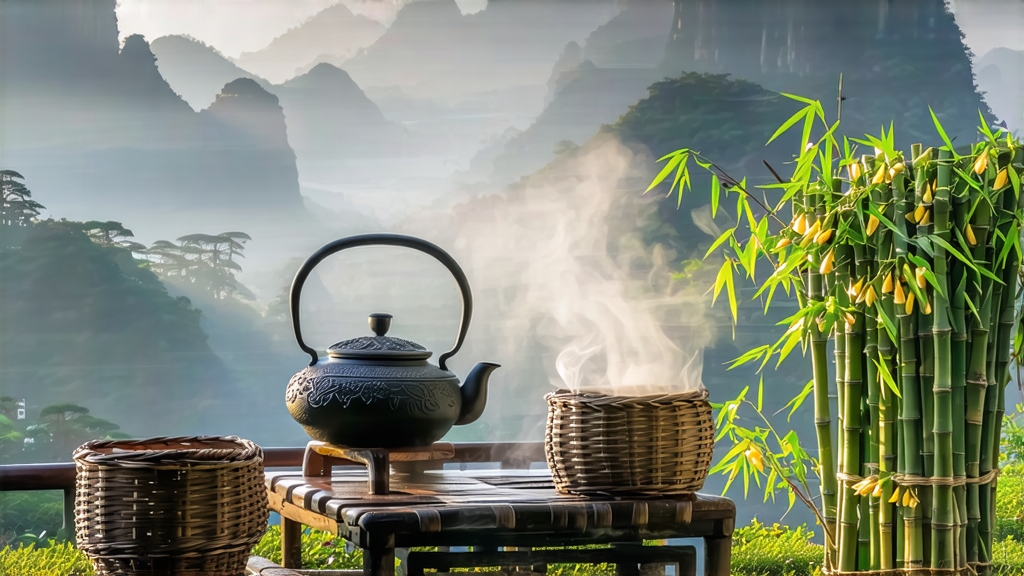
Tucked high in the mist-veiled Dabie Mountains of western Anhui Province, a tea once reserved for emperors quietly survives the rush of modern commerce. Huoshan Huangya—literally “Yellow Bud of Huoshan”—is the least-known member of China’s six great tea families, yet it carries the most delicate alchemy between green freshness and black depth. To understand it is to witness a three-day choreography of heat, moisture and time that turns a spring bud the color of old ivory and the flavor of mountain orchards after rain.
Historical whispers
The first written record appears in the Shennong Bencao Jing (2nd century BCE), but Huoshan Huangya steps clearly onto the stage during the Tang dynasty (618-907) when Lu Yu, the “Sage of Tea,” listed Huoshan among the fourteen superior tea prefectures. By the Ming dynasty it had become tribute tea; caravans carried sealed bamboo tubes of the downy buds to the Forbidden City where eunuchs measured it out by the gram for the Dragon Throne. When the Qing turned to darker, longer-keeping teas for export, yellow tea techniques were guarded inside family lineages, almost disappearing during the 1930s wars. A state-led revival in 1972 returned wild old bushes to cultivation, yet even today fewer than 30 tons reach the market each year, most snapped up by collectors in Shanghai and Tokyo before the leaves finish cooling.
Micro-terroir
Huoshan county straddles 31° N at 600–800 m elevation. Granite peaks trap monsoon clouds, giving 180 foggy days annually; the short-wave ultraviolet light thickens leaf amino acids, while cool nights slow oxidation precursors. The local cultivar, Huoshan Da Ye Zhong, has unusually large, tender buds—one weighs 0.35 g, twice that of Longjing—packed with soluble sugars that later feed the “menhuang” microbial fermentation. Soils are yellow-brown laterite, slightly acidic (pH 5.2) and laced with selenium leached from porphyry veins, a trace element that translates into a subtle sweetness on the tongue.
Plucking ritual
The harvest window opens on the first day the local wagtail sings before dawn—usually 5 April, the solar term Qingming. Only the “sparrow-tongue” bud and its imminent first leaf are taken, when 60 % of the bud is still hidden inside the sheath. Experienced pickers pinch sideways so the tiny fish-scale white hairs remain intact; any broken hairs will oxidize into rusty spots during menhuang. A full kilo of finished tea needs 48 000 such tips, enough to fill two bamboo baskets carried downhill on foot within two hours to keep field heat low.
Crafting yellow: the menhuang miracle
Yellow tea is not simply “slightly oxidized green tea.” It undergoes a unique smother-fermentation step that nudges chlorophyll toward pheophytin while allowing non-enzymatic browning. Huoshan Huangya is processed over 72 hours in five acts:
- Sha-qing (kill-green): 180 °C on a dark-cast wok for 3.5 minutes—longer than green tea—to drive off grassiness yet keep 12 % moisture.
- Re-nian (hot rolling): the leaves are wrapped in a hemp cloth and rolled under 8 kg pressure for four minutes, rupturing 35 % of cell walls without squeezing juice out.
- Maohuo (initial firing): 80 °C for 40 minutes reduces moisture to 20 %; the leaf edges feel crisp while the stem remains rubbery—critical for the next step.
- Menhuang (yellowing): the hot leaves are piled 8 cm deep inside a cedar box lined with wet cotton; the box is slid into a 28 °C, 75 % RH room for 48 hours. Facultative anaerobes convert sugars into lactic acid, dropping pH from 6.1 to 5.4 and shifting the color spectrum from chlorophyll green to pheophytin yellow. Every six hours the pile is fluffed to re-oxygenate; by the end the leaf smells of fresh corn milk.
- Zuohuo (final firing): slow charcoal bake at 60 °C for two hours locks in the golden liquor and adds a whisper of chestnut.
The